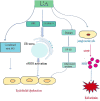Excess Uric Acid Induces Gouty Nephropathy Through Crystal Formation: A Review of Recent Insights
- PMID: 35909538
- PMCID: PMC9329685
- DOI: 10.3389/fendo.2022.911968
Excess Uric Acid Induces Gouty Nephropathy Through Crystal Formation: A Review of Recent Insights
Abstract
Uric acid (UA) is the final product of purine metabolism in the human body, and impaired purine metabolism can increase the uric acid in serum, finally resulting in hyperuricemia (HUA). Current evidences suggest that urates might have antioxidant properties under certain circumstances, but most evidences suggest that urates promote inflammation. Hyperuricemia leads to the formation of urate crystals, which might be recognized as a red flag by the immune system. Such a response stimulates macrophage activation, leads to the activation of NOD-like receptor protein 3 (NLRP3) inflammasome vesicles, and ultimately the production and liberation of interleukin-1b (IL-1b) and interleukin-18 (IL-18), which can mediate inflammation, apoptosis and necroinflammation and cause an inflammatory cascade response. The kidney is one of the most commonly affected organs in HUA, which promotes the development of chronic kidney disease (CKD) by damaging endothelial cells, activating the renin-angiotensin system (RAS), and promoting inflammatory responses. Pharmacological interventions and lifestyle modifications are the primary means for controlling gout and lowering UA. The febuxostat is safe for CKD patients in the UA lowering therapy. Although dialysis can reduce UA levels, the application of drug is also necessary for dialysis patients. This article reviews the synthesis and metabolism of UA, etiology of HUA, the relationship between HUA and kidney disease, the treatment of gout and gouty nephropathy (GN).
Keywords: gout; gouty nephropathy; hyperuricemia; treatment; uric acid.
Copyright © 2022 Mei, Dong, Geng and Xu.
Conflict of interest statement
The authors declare that the research was conducted in the absence of any commercial or financial relationships that could be construed as a potential conflict of interest.
Figures

Similar articles
-
The dysregulation of immune cells induced by uric acid: mechanisms of inflammation associated with hyperuricemia and its complications.Front Immunol. 2023 Nov 20;14:1282890. doi: 10.3389/fimmu.2023.1282890. eCollection 2023. Front Immunol. 2023. PMID: 38053999 Free PMC article. Review.
-
The role of hyperuricemia in the progression of end-stage kidney disease and its molecular prospective in inflammation and cardiovascular diseases: A general review.Ther Apher Dial. 2025 Feb 18. doi: 10.1111/1744-9987.70000. Online ahead of print. Ther Apher Dial. 2025. PMID: 39966090 Review.
-
Phloretin ameliorates hyperuricemia-induced chronic renal dysfunction through inhibiting NLRP3 inflammasome and uric acid reabsorption.Phytomedicine. 2020 Jan;66:153111. doi: 10.1016/j.phymed.2019.153111. Epub 2019 Oct 16. Phytomedicine. 2020. PMID: 31790902
-
Renal safety and urate-lowering efficacy of febuxostat in gout patients with stage 4-5 chronic kidney disease not yet on dialysis.Korean J Intern Med. 2020 Jul;35(4):998-1003. doi: 10.3904/kjim.2018.423. Epub 2019 Apr 8. Korean J Intern Med. 2020. PMID: 30959584 Free PMC article.
-
Molecular Biological and Clinical Understanding of the Pathophysiology and Treatments of Hyperuricemia and Its Association with Metabolic Syndrome, Cardiovascular Diseases and Chronic Kidney Disease.Int J Mol Sci. 2021 Aug 26;22(17):9221. doi: 10.3390/ijms22179221. Int J Mol Sci. 2021. PMID: 34502127 Free PMC article. Review.
Cited by
-
Pharmacological and Therapeutic Applications of Esculetin.Int J Mol Sci. 2022 Oct 20;23(20):12643. doi: 10.3390/ijms232012643. Int J Mol Sci. 2022. PMID: 36293500 Free PMC article. Review.
-
Regulating Lipid Metabolism in Gout: A New Perspective with Therapeutic Potential.Int J Gen Med. 2024 Nov 12;17:5203-5217. doi: 10.2147/IJGM.S499413. eCollection 2024. Int J Gen Med. 2024. PMID: 39554874 Free PMC article. Review.
-
Overview of pharmacodynamical research of traditional Chinese medicine on hyperuricemic nephropathy: from the perspective of dual-regulatory effect on the intestines and kidneys.Front Pharmacol. 2025 Apr 8;16:1517047. doi: 10.3389/fphar.2025.1517047. eCollection 2025. Front Pharmacol. 2025. PMID: 40264662 Free PMC article. Review.
-
Relationship between renal function and cognitive impairment in patients with stable schizophrenia: a multicenter cross-sectional study.BMC Psychiatry. 2025 May 15;25(1):494. doi: 10.1186/s12888-025-06952-8. BMC Psychiatry. 2025. PMID: 40375202 Free PMC article.
-
Chinese Sumac (Rhus chinensis Mill.) Fruits Prevent Hyperuricemia and Uric Acid Nephropathy in Mice Fed a High-Purine Yeast Diet.Nutrients. 2024 Jan 5;16(2):184. doi: 10.3390/nu16020184. Nutrients. 2024. PMID: 38257077 Free PMC article.
References
-
- Yanai H, Adachi H, Hakoshima M, Katsuyama H. Molecular Biological and Clinical Understanding of the Pathophysiology and Treatments of Hyperuricemia and Its Association With Metabolic Syndrome, Cardiovascular Diseases and Chronic Kidney Disease. Int J Mol Sci (2021) 22(17):9221. doi: 10.3390/ijms22179221 - DOI - PMC - PubMed
Publication types
MeSH terms
Substances
LinkOut - more resources
Full Text Sources
Medical
Miscellaneous

